How to Make a Copper Bartop, Countertop, or Tabletop
You can make a copper bar top, countertop, or tabletop from just about any thickness of copper that we offer, and your cost will vary depending on which you choose. The thickness you go with really depends on the look you are going for, the use the countertop will see, the installation plan, and overall personal preference.
5 Mil (36 Gauge) Copper Foil is one very popular choice. It is a thin material, and for that reason, it is easy to cut and easy to bend. However, it can dent or wrinkle so the installation has to be done carefully. You would want to attach the 5 mil to a very smooth substrate such as MDF or possibly plywood. Keep in mind that any lumps and bumps on the board will be embossed onto the copper sheet, so the smoothness is essential. The 5 mil is usually attached using a contact-type adhesive. The brush on varieties are popular, and some others will use Spray 90 or Super 77 by 3M. Typically, the adhesive is applied to both surfaces (Be sure to use plenty of adhesive as the wood substrate will absorb some of the adhesive.), then dowels will be placed on top of the substrate, across the width and extending over the edge a bit, and then the copper sheet placed over the top of the dowels. This allows you to line up the copper with the edge because once the copper is glued, it cannot be replaced without damaging it. One by one the dowels are removed and the copper is rolled with a rubber laminate roller. This is an essential step to setting the adhesive and removing any air bubbles. Some people will add tacks or nails, for a decorative effect and/or extra security, though these are optional. One of the most important distinctions about working with the 5 mil is that you really need to cover it with a heavy-duty sealant. This will create a durable counter that is easy to maintain. Without it, the 5 mil may be damaged. Most people will use either a two part clear, air drying polyurethane or a flood coat of two part epoxy resin in order to create the most durable surface.
Sometimes people will prefer the thicker material, such as the 16 Mil (26 Gauge) Copper Sheeting or 22 Mil (24 Gauge) Copper Sheeting. This material is sometimes preferable if you are hoping to achieve a less shiny and smooth look, such as if you'd like to hammer the copper or have it appear somewhat distressed. It is also preferable if you do not want to seal the copper and plan to let it age and develop a natural patina over time. Going without a sealant also allows you to benefit from the antimicrobial qualities of copper. This material is typically attached to a plywood substrate, or other surfaces, using a heavy-duty construction adhesive such as Liquid Nails or contact cement, often with nails as well. The smoothness of the substrate is not as essential because the material is not so thin that it will emboss the imperfections. You can apply a sealant to this material if you want to protect it from distressing, want to create your own patina and preserve it, or don't want a patina to develop at all.
People also use the 10 Mil (30 Gauge) Copper Sheeting which is in between these options in terms of durability, as well as how to handle the installation. If you have a high use countertop and you prefer the 10 mil or want to seal a patina, you would probably want to use a heavy-duty sealant such as our Two Part Solvent Urethane Resin or a flood coat of a two part epoxy resin. If it is a countertop that is not used frequently, or you prefer a more rustic look where dents and dings only add to the character, then it may very well be fine if you treat it as the 16 or 22 mil.
You can see several examples of copper bar tops and countertops in our Photo Gallery and on our Project Ideas page. Below are links to a few of these:
A nice example of a countertop made from 5 mil, where the customer created her own patina design and sealed with a two-part clear, polyurethane: Copper Countertop and Copper Island by Beth Wright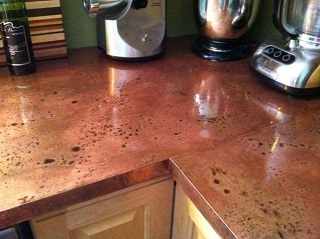
An example of a bar top using our 5 mil Rojo aged patina sheets sealed with a flood coat of a two part epoxy resin: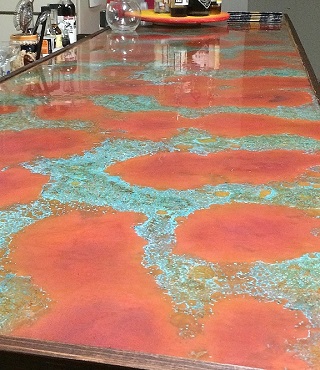
Another example of a 5 mil counter top, with customer-created patina, and a flood coat of a 2 part epoxy resin sealant - this time wood trim: Carmichael Countertop
Photos of a before and after counter top, again with 5 mil: Wren Copper Countertop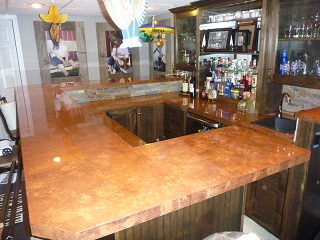
A curved countertop made with 22 mil copper, with decorative (and functional) nails at the seams : https://basiccopper.com/copper-bartop-do-it-yourself.html
Antique Apple Sorting Table using our 22 Mil Copper Sheeting https://basiccopper.com/copper-table-antique-apple-sorting.html
A Copper Bar Top using 16 mil copper: https://basiccopper.com/coco.html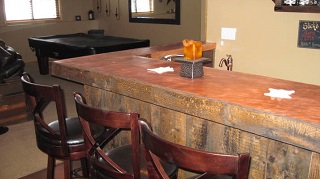
A dining room table wrapped in 10 mil: https://basiccopper.com/coditacrbr.html
A copper bar top using our Hammered Copper Sheets
Also don’t forget to checkout our full selection of Aged Patina Copper Sheets: https://basiccopper.com/copper-patina-sheets.html. These come in Lightweight, 5 Mil (36 gauge) and Heavyweight, 22 mil/16 oz. (24 gauge)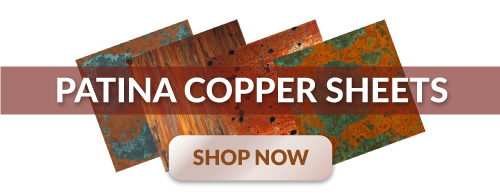
See Basic Copper's thickness guide for a video description of each thickness.
If you have any questions, please don't hesitate to contact via phone at 252-491-2812, email at info@basiccopper.com, or our chat service and we’d be happy to discuss your project with you!

